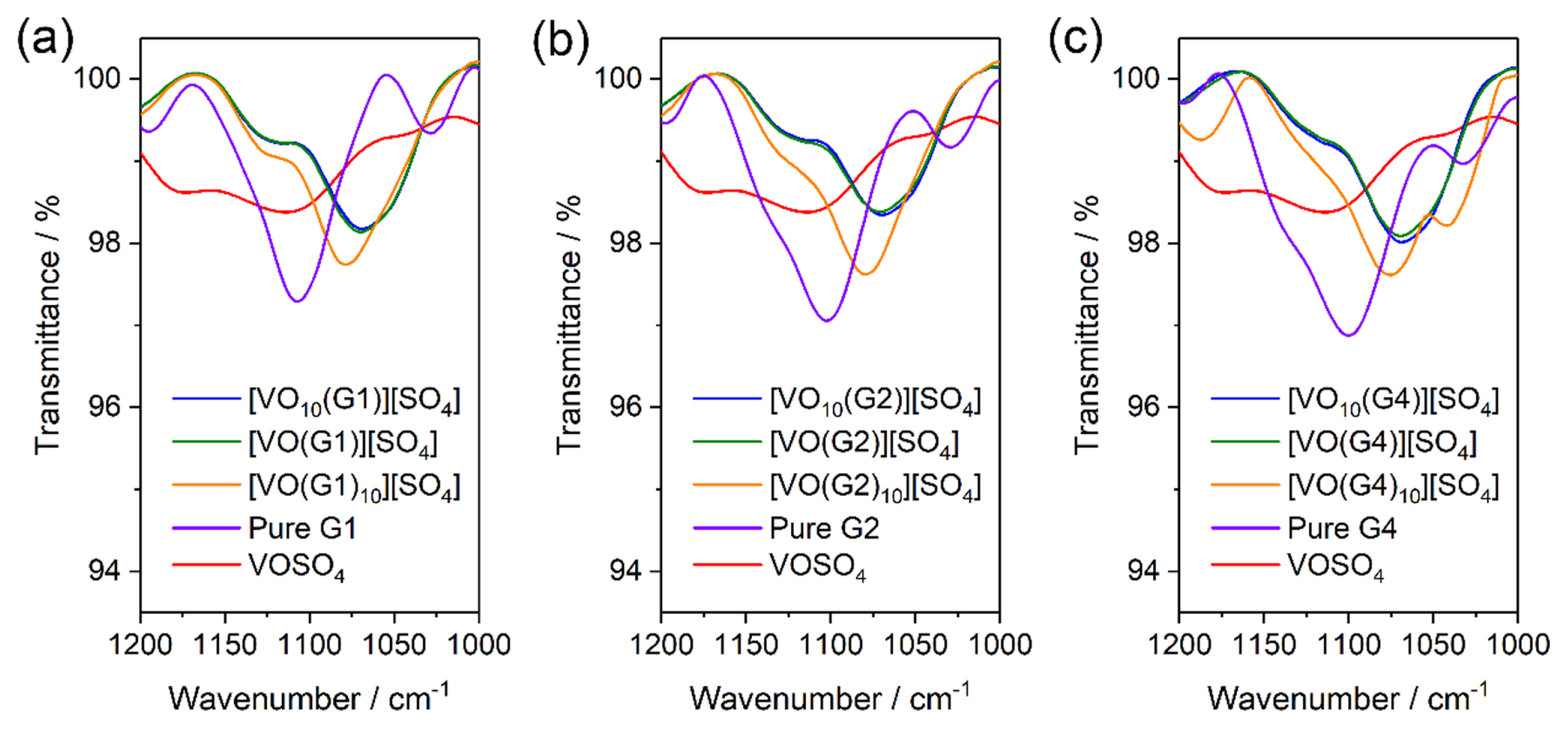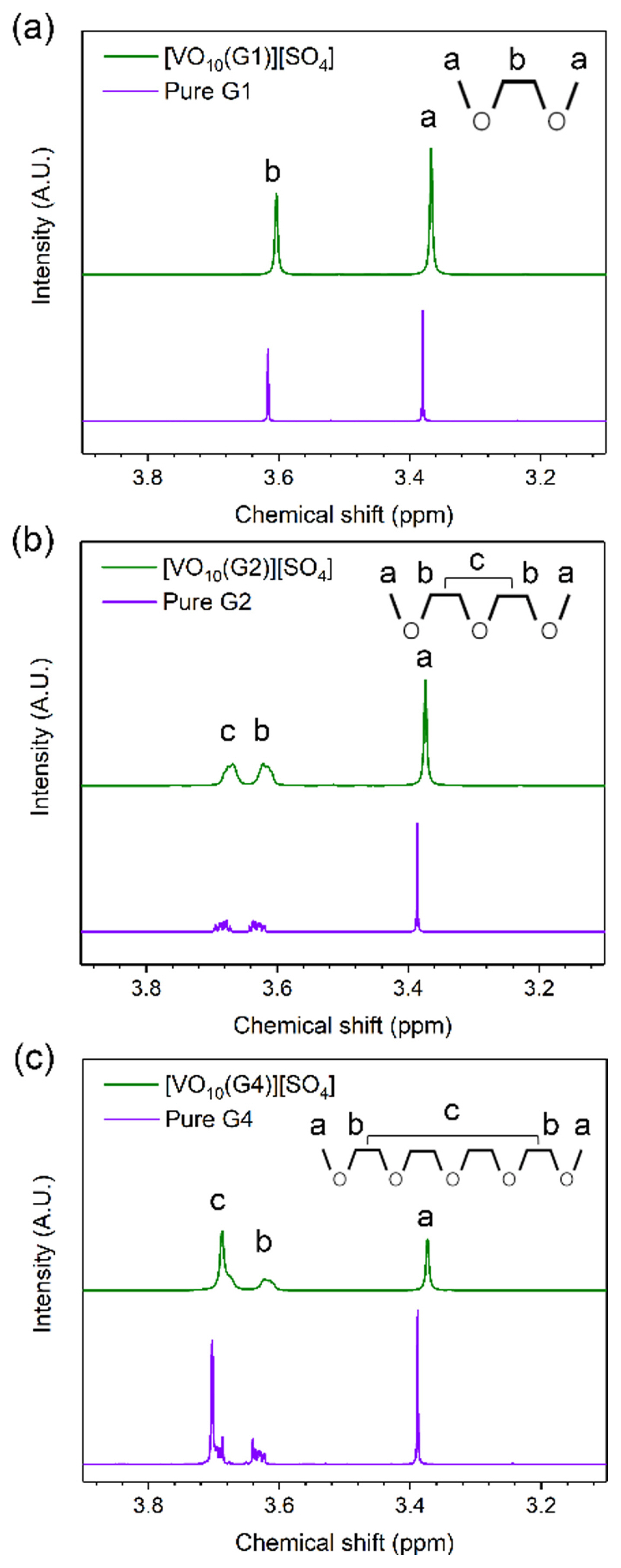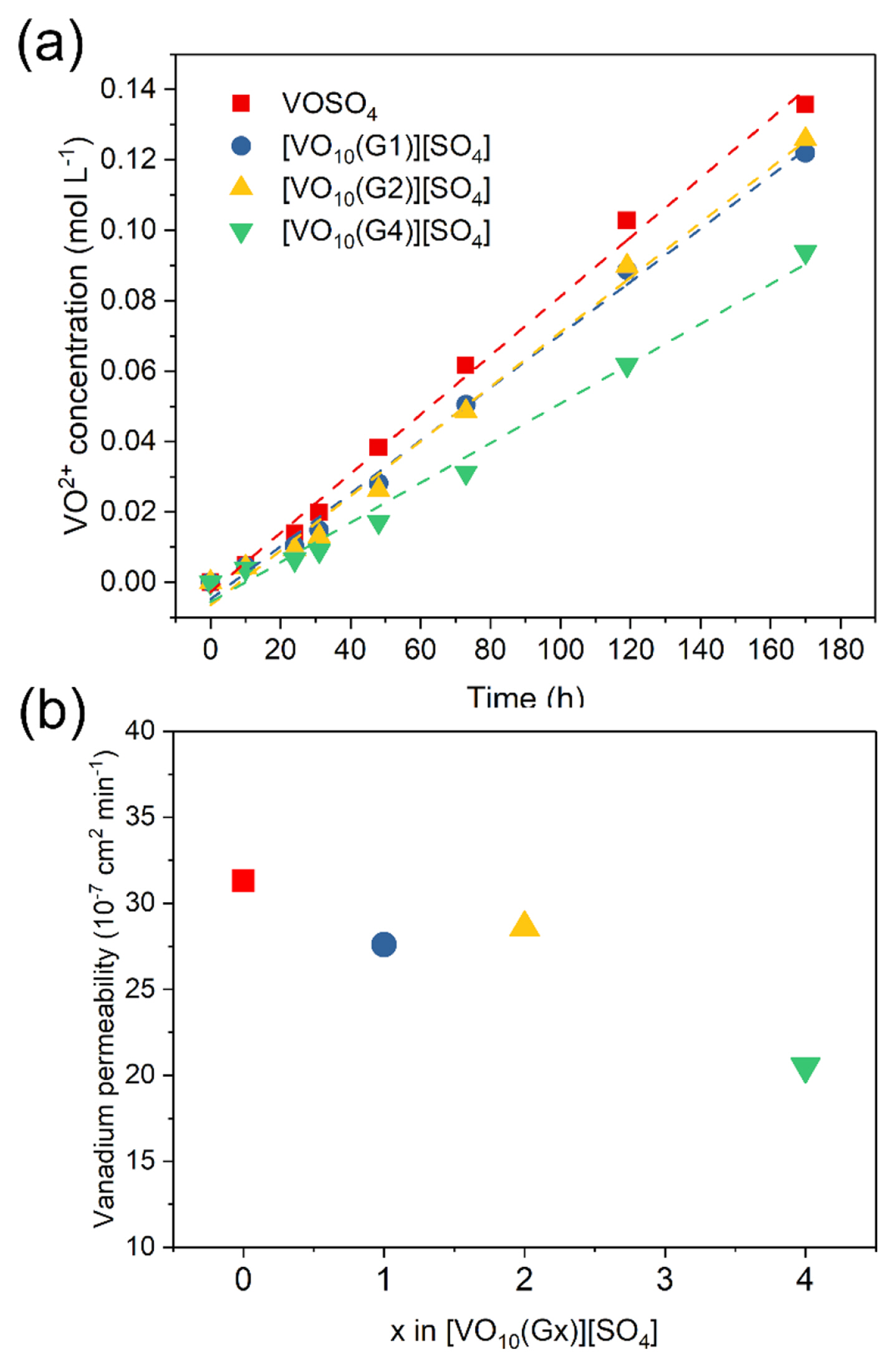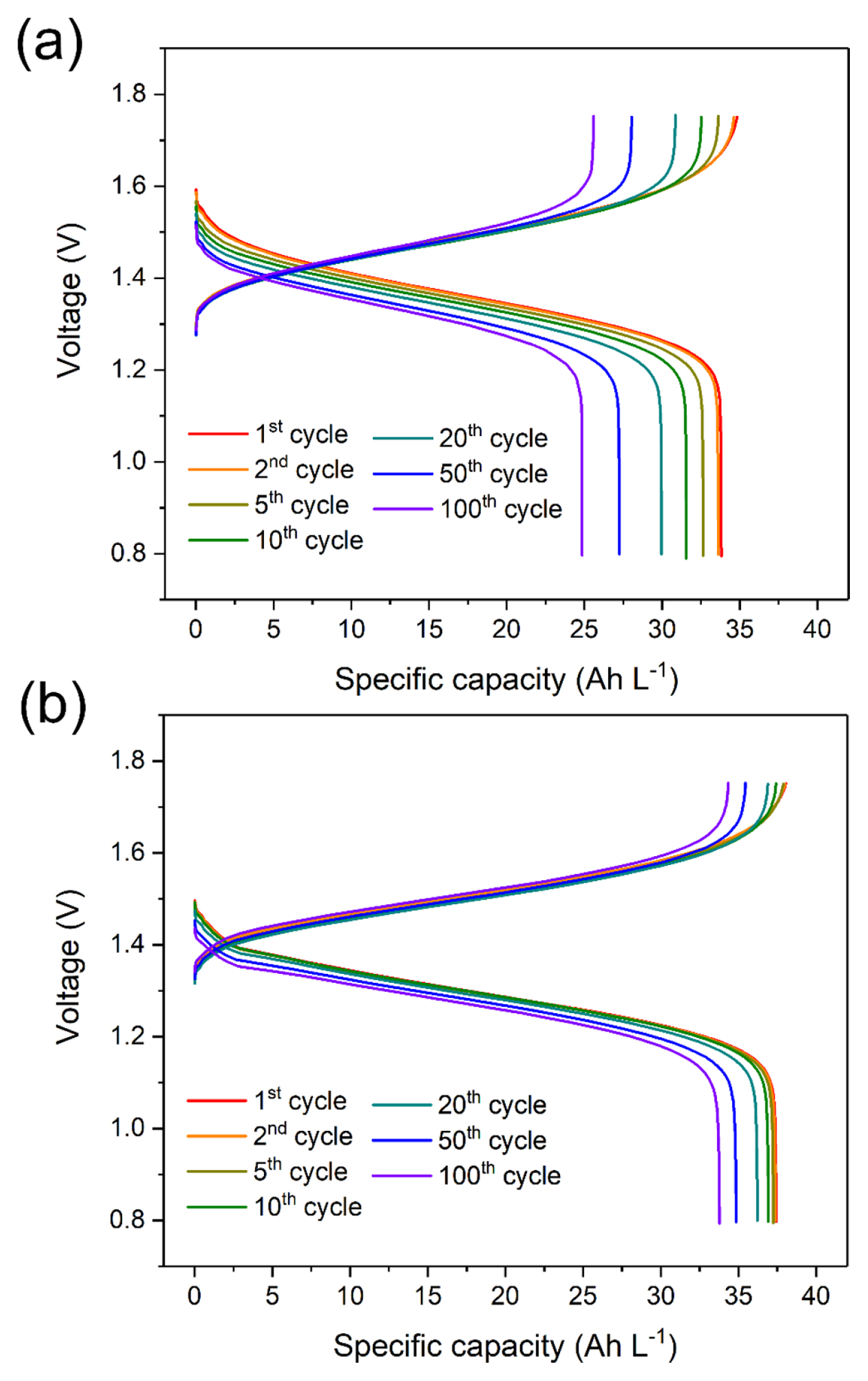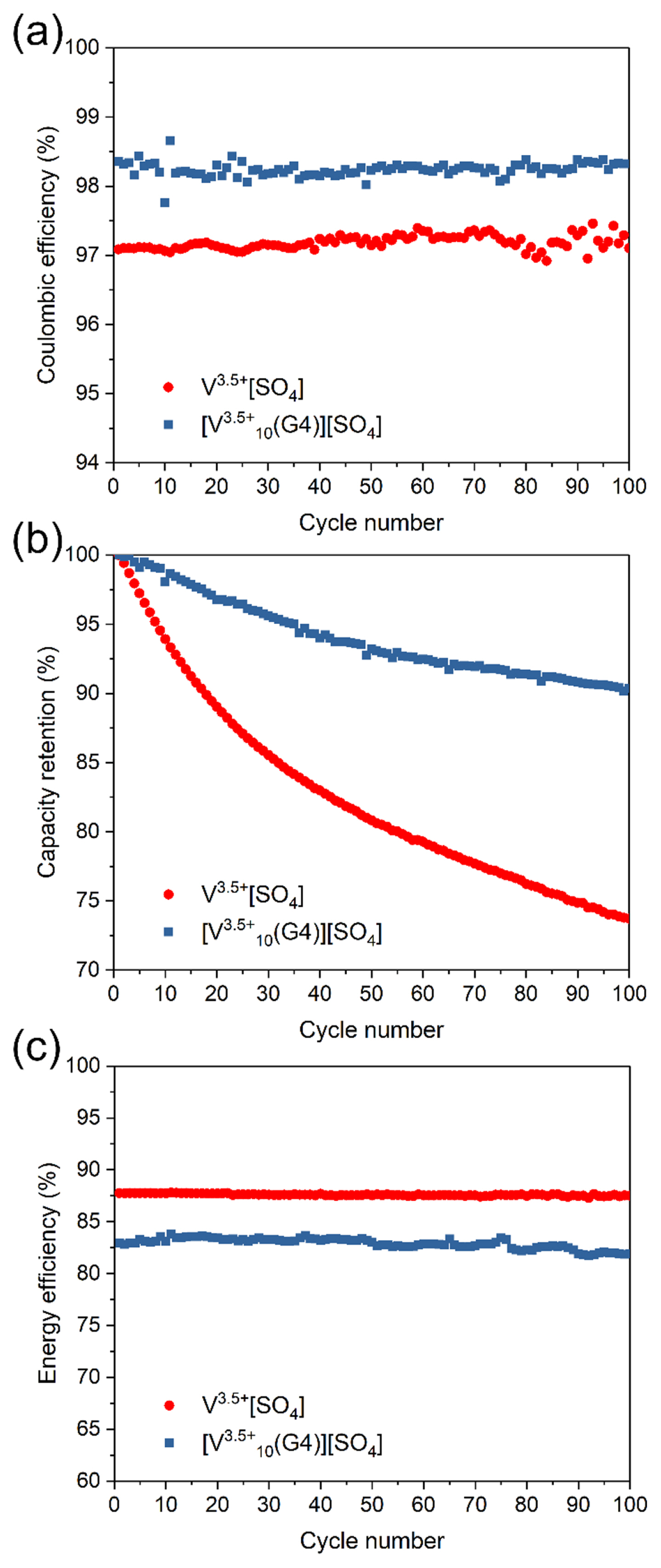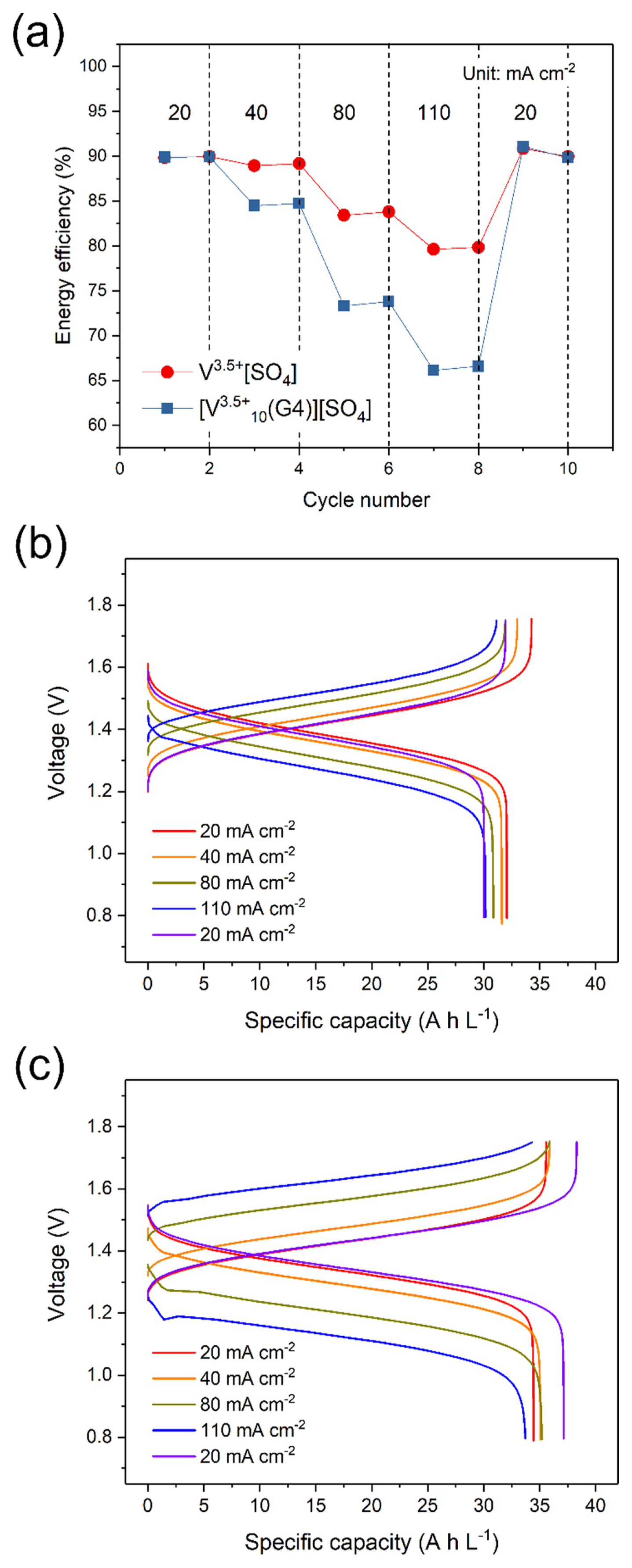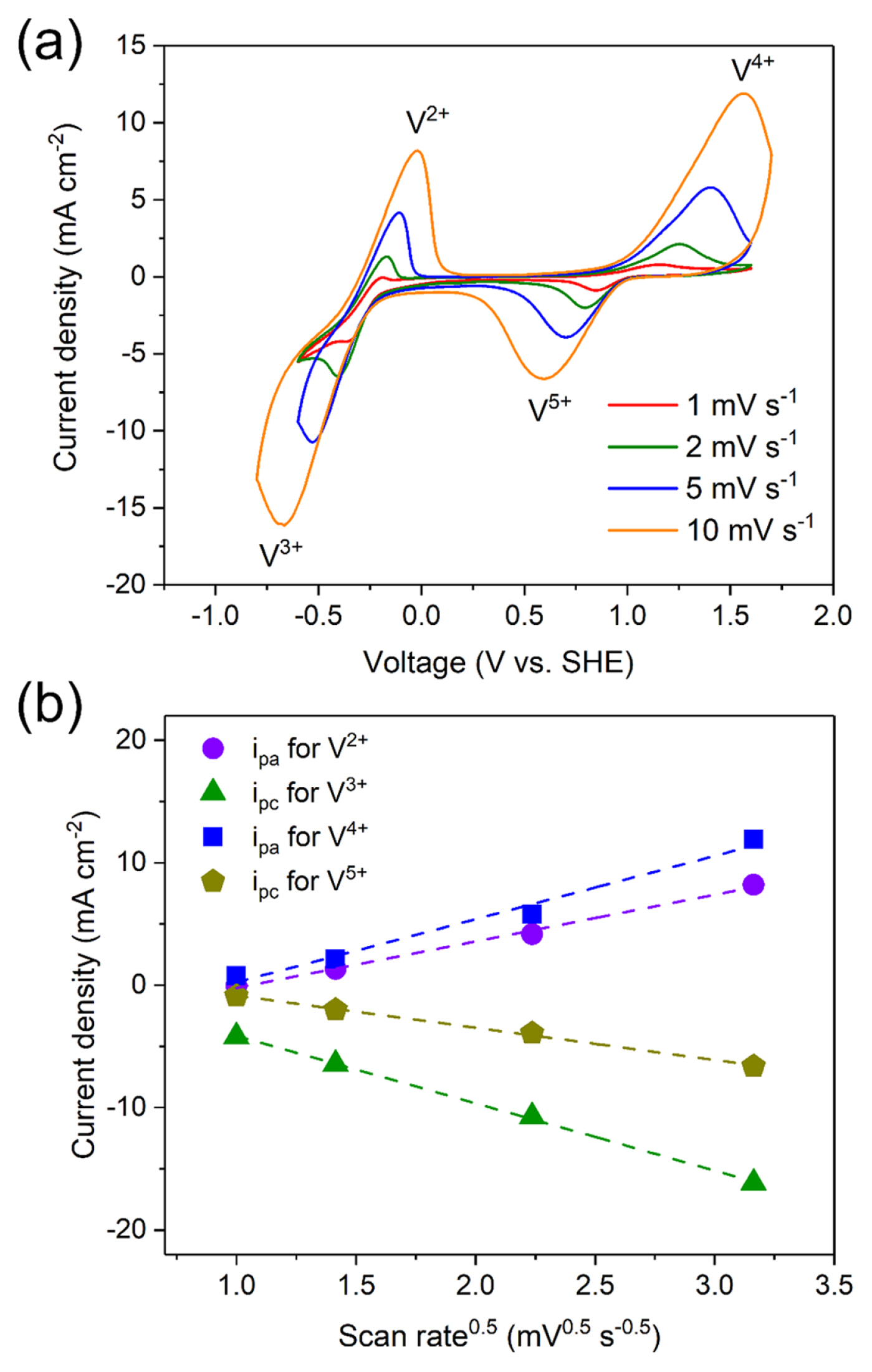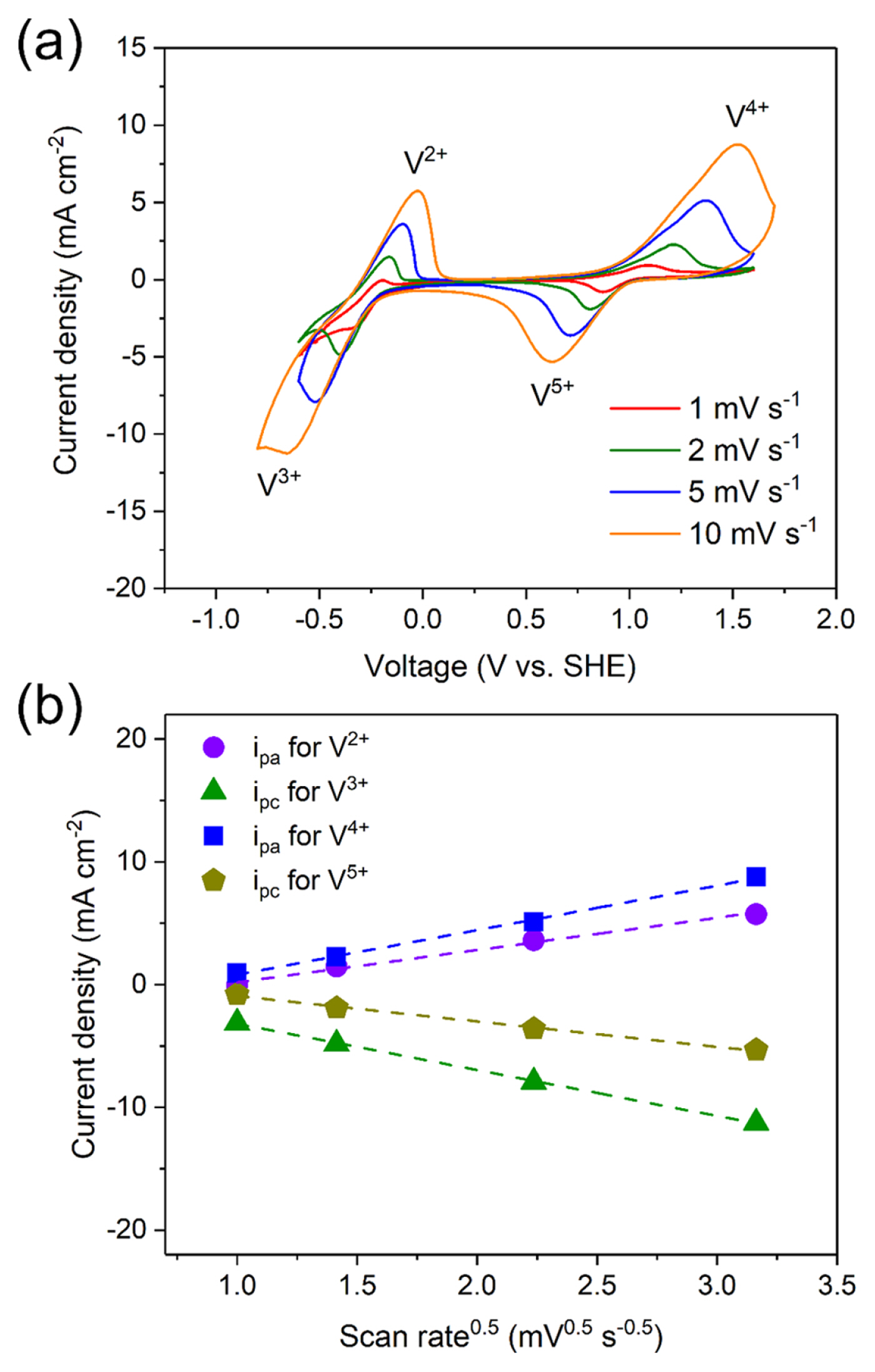1. Introduction
As global environmental issues accelerate, much effort has been devoted to replace fossil fuels with renewable energy. In this regard, large scale energy storage systems (ESSs) have attracted attention to efficiently store renewable energy in the form of electricity [1–4]. Aqueous redox flow batteries, such as vanadium redox flow batteries (VRFBs) and zinc-bromine flow batteries, have been considered one of the promising power sources for ESSs because of their excellent cycle performance and good safety [5–8]. VRFBs are composed of catholyte, anolyte, and ion-selective membrane [9–12]. One of the functions of the ion-selective membrane is to inhibit vanadium cation crossover between catholyte and anolyte because vanadium crossover gives rise to self-discharge, resulting in poor Coulombic efficiency [13–15]. Moreover, vanadium crossover gives rise to cell imbalance between catholyte and anolyte due to osmotic pressure, leading to capacity fading during cycling [16,17]. The Nafion membrane, consisting of perfluorinated backbone and negatively charged sulfate functional group, has been conventionally used as a membrane for VRFBs because the Nafion membrane showed promise in the electrochemical performance of VRFBs. This is attributed to the fact that Nafion is chemically stable against acidic electrolytes and its ionic conductivity is sufficiently high [18,19]. However, vanadium crossover is still one of the challenging issues for VRFBs with the Nafion membrane because the Nafion membrane is not perfectly ion selective for vanadium cations [20–22].
The Nafion membrane, which is a kind of cation-exchange membrane, has ion transport channels with ca. 10 Å in diameter. Since this channel is permeable with not only protons but also vanadium cations, vanadium crossover through the channel occurs during cycling. For this reason, new membranes have been introduced to suppress vanadium crossover [23–26]. For example, anion exchange membranes tethered containing positively charged functional groups, were examined for VRFBs because they are selectively permeable only to anions, thus suppressing the crossover of vanadium cations [27,28]. Size exclusive membranes were also introduced to suppress vanadium crossover. The channel size of size exclusive membranes was controlled to permeate only protons but not large vanadium cations [29,30]. Inspired by the ion-selective behavior of the size exclusive membranes, we introduced vanadium complexes with glyme ligands as active materials to significantly increase the size of vanadium cations, thus inhibiting the crossover of vanadium cations through the Nafion membrane. Glymes can solvate various cations, such as lithium, sodium, and magnesium [31–33]. Vanadium ions are also known to be complexed with a few ligands in water, such as vanadium-diethylenetriaminepentaacetate (DTPA) complex ([V(DTPA)]2−) [34] and vanadium-poly(γ-glutamic acid) [35]. In this regard, using infrared (IR) and nuclear magnetic resonance (NMR) spectroscopies, we directly evidenced the formation of vanadium complexes with various glymes, such as monoglyme, diglyme, and tetraglyme, depending on the chain length of glymes. These glymes were examined as electrolyte additives for VRFBs. We measured the vanadium permeability of the Nafion membrane for various glyme additives. As the chain length of glymes increased, the size of vanadium-glyme complexes increased. For this reason, the vanadium permeability of the Nafion membrane decreased with increasing the chain length of glymes. In particular, the tetraglyme additive showed excellent electrochemical performance, such as stable capacity retention (90.4% after 100 cycles) and high Coulombic efficiency (98.2% over 100 cycles). However, the tetraglyme additive showed large overpotential compared to the conventional bare electrolyte containing no additives. This was attributed to the low ionic conductivity and diffusivity of vanadium-glyme complexes due to the steric effect.
2. Experimental
2.1 Materials
Monoglyme (1,2-dimethoxyethane), diglyme (diethylene glycol dimethyl ether), tetraglyme (tetraethylene glycol dimethyl ether), MgSO4 powders, and H2SO4 were purchased from Sigma-Aldrich. VOSO4 powders (Thermo-fisher) was used to prepare vanadium-glyme complexes. For the preparation of vanadium-glyme complexes, monoglyme, diglyme, tetraglyme were dissolved in aqueous 10 mM VOSO4 solutions for various molar ratios of glymes to VOSO4. These solutions were used to perform IR and NMR spectroscopies. Commercial vanadium electrolyte (1.6 M V3.5+ and 2.0 M H2SO4, Oxkem Ltd.) was used to evaluate the electrochemical performance of VRFBs. Nafion 115 membrane and carbon felt (Toyobo XF-30A) was purchased FC international.
2.2 Materials Characterizations
FT-IR spectrophotometer (TENSOR 27, Bruker, Germany) was used to examine the formation of vanadium complexes with glyme additives. 1H NMR spectra (AvanceIII-500, Bruker, Germany) were acquired using D2O as a solvent at room temperature. Ultraviolet-visible (UV-vis) spectroscopy (Cary 5000 UV-Vis-NIR, Agilent, USA) was carried out to measure the vanadium concentration of solutions. For the measurement of vanadium permeability, we used H-type cells, in which the donor and receptor chambers were separated by a Nafion 115 membrane. The donor chamber was filled with 18 mL of aqueous solutions of 0.5 M VOSO4 and 1.0 M H2SO4 containing various amounts of glyme additives. The receptor chamber was filled with 18 mL of aqueous solutions of 0.5 M MgSO4 and 1.0 M H2SO4. Both solutions in the donor and receptor chambers were continuously stirred at 200 rpm during the measurement. Nafion 115 membranes were immersed in distilled water at room temperature overnight prior to use. The viscosity of electrolytes was measured at 25°C using a rheometer (DHR-2, TA instrument, USA).
2.3 Electrochemical characterization
The ionic conductivity of electrolytes was measured using electrochemical impedance spectroscopy (EIS) with a home-made H-type Swagelok cell. EIS analysis was carried out using SP-150 (Biologic, France) in a frequency range from 500 kHz to 1 Hz at a potential amplitude of 10 mV. Two stainless steel electrodes (1.04 cm in diameter) were separated by a distance of 7.37 cm. For the preparation of vanadium complex solutions with various vanadium concentrations from 0.2 M and 1.6 M, commercial Oxkem electrolytes were mixed with glymes and then diluted with distilled water. Cyclic voltammetry (CV) was performed using a WBCS 3000 (WonATech, Korea). CV profiles were obtained using a beaker-type cell. Carbon felt electrodes were used as working and counter electrodes, and standard hydrogen electrode was used as a reference electrode. 30 mL of aqueous solutions of 10 mM VOSO4 and 100 mM H2SO4 containing 1 mM tetraglyme was prepared for the measurement. The electrochemical performances of vanadium-glyme complexes were evaluated using a battery measurement system (WBCS 3000, WonATech, Korea) in a voltage range of 0.8–1.75 V at a current density of 40 mA cm−2. 30 mL of Oxkem electrolytes were pumped at a flow rate of 40 mL min−1. Coulombic efficiency and energy efficiency were calculated using the equations below,
3. Results and Discussion
3.1 Formation of vanadium complexes with glymes
To elucidate the role of vanadium-glyme complexes in suppressing the vanadium crossover of the Nafion membrane in VRFBs, we examined various glymes, such as monoglyme (denoted as G1), diglyme (denoted as G2), and tetraglyme (denoted as G4), depending on the chain length of glymes, as complexing agents for vanadium cations. Fig. 1 shows the IR spectra of bare glymes and aqueous 10 mM VOSO4 solutions containing various amounts of glymes. The molar ratio of VO2+ to glymes varied from 10 to 0.1. Aqueous 10 mM VOSO4 solutions containing glymes are denoted by [VO10(Gx)][SO4], [VO(Gx)][SO4], and [VO(Gx)10][SO4] (x = 1, 2, and 4), depending on the molar ratio of VO2+:glymes, such as 10:1, 1:1, and 1:10, respectively. A broad peak at ca. 1,100 cm−1 corresponds to the C-O stretch vibration band of bare glymes. As the molar ratio of VO2+ to glymes increased, the C-O stretch vibration band of all glymes redshifted gradually. This implies that VO2+ was complexed with all glymes [36,37]. The complexation of VO2+ with glymes was further supported by NMR spectroscopy. Fig. 2 compares the 1H NMR spectra of bare glymes and aqueous 10 mM VOSO4 solutions containing glymes. The molar ratio of glymes to VO2+ was fixed at 0.1. Peaks at 3.4 ppm and at 3.6–3.7 ppm in the 1H NMR spectra are assigned by hydrogen atoms in methyl and methylene groups, respectively. The NMR peaks indicated by the symbols of a, b, and c correspond to hydrogen atoms in the glyme molecular structures indicated by the same symbols of a, b, and c, respectively, as shown in the insets of Fig. 2. The NMR peaks of aqueous 10 mM VOSO4 solutions containing glymes were upshifted compared to those of bare glymes. In addition, peak broadening was observed for aqueous VOSO4 solutions containing glymes. Since both chemical shift and peak broadening are known to be due to the complexation of glymes with cations, the NMR spectra of aqueous VOSO4 solutions containing glymes reveals that VO2+ ions were chelated with glymes [38,39].
3.2 Vanadium-glyme complexes suppressing the vanadium crossover of the Nafion membrane
In order to demonstrate the steric effect of vanadium-glyme complexes on the vanadium permeability of the Nafion membrane, we measured the vanadium permeability of the Nafion membranes for various glyme ligands using a H-type cell, in which the molar ratio of VO2+ to glymes was fixed at 10 ([VO10(Gx)][SO4]: x = 1, 2, and 4). The donor and receptor chambers were filled with aqueous solutions of 0.5 M VOSO4 in 1 M H2SO4 and 0.5 M MgSO4 in 1 M H2SO4, respectively. The same salt concentration of two chambers was used to avoid osmotic pressure between two chambers. The VO2+ concentration of the receptor chamber was measured using UV-Vis spectroscopy. The concentration of VO2+ was estimated using a peak intensity at 765 nm in the UV-Vis spectra of the solutions retrieved from the receptor chamber [40]. Fig. 3(a) shows the VO2+ concentration of the solutions in the receptor chamber as a funct ion of time for bare VOSO4, [VO10(G1) ] [SO4], [VO10(G2) ] [SO4], and [VO10(G4)][SO4]. The VO2+ concentration increased with increasing time. This is due to vanadium crossover through the Nafion membrane. The slope of the linear plot between VO2+ concentration and time was correlated with the permeability of vanadium cations, as shown in the Fick’s diffusion law [41],
where VR, CR(t), CD, A, P, L, and t are the volume of liquids in a receptor chamber, ion concentration as a function of time, the initial ion concentration of solutions in a donor chamber, effective membrane area, vanadium permeability, membrane thickness, and time, respectively. Fig. 3(b) shows the vanadium permeability of the Nafion membranes for bare VOSO4, [VO10(G1)][SO4 ], [VO10(G2)][SO4 ], and [VO10(G4)][SO4]. The vanadium permeability of bare VOSO4 was 31.3×10−7 cm2 min−1, whereas those of [VO10(G1)][SO4], [VO10(G2)][SO4], and [VO10(G4)][SO4] were 27.6, 28.6, and 20.5×10−7 cm2 min−1, respectively. The vanadium permeability of bare VOSO4 was larger than those of vanadium-glyme complexes, revealing that vanadium-glyme complexes suppressed the vanadium crossover of the Nafion membrane. In addition, the vanadium permeability of vanadium-glyme complexes decreased with increasing the chain length of glymes. This implies that the vanadium permeability of the Nafion membrane was inversely proportional to the size of vanadium-glyme complexes. This implies that the diffusion rate of vanadium species in the small channel of the Nafion membrane decreased with increasing the size of vanadium-glyme complexes. This is due to the steric effect of vanadium-glyme complexes [42,43].
3.3 Electrochemical performance of the vanadium-tetraglyme complexes
We compared the electrochemical performances of conventional vanadium electrolyte and the vanadium-G4 complex electrolyte to investigate the role of glyme ligands in the electrochemical performance of VRFBs [44]. A VRFB single cell was assembled with two graphite electrodes (5×5 cm2) separated by the Nafion membrane (8×8 cm2). The single cells were operated using a commercial vanadium electrolyte of 1.6 M vanadium (V3.5+) sulfate in 2 M sulfuric acid at a flow rate of 40 mL min−1. Fig. 4 shows the voltage profiles of VRFBs for commercial Oxkem electrolytes without G4 additive (denoted as V3.5+[SO4]) and with G4 additive (denoted as [V3.5+10(G4)][SO4]) at a current density of 40 mA cm−2 during 100 cycles. The molar ratio of V3.5+:G4 was 10:1 for [V3.5+10(G4)][SO4]. As shown in Fig. 5(a), we compared the Coulombic efficiency of V3.5+[SO4] and [V3.5+10(G4)][SO4]. The Coulombic efficiency of [V3.5+10(G4)][SO4] was significantly higher than that of bare V3.5+[SO4]. This is attributed to the fact that the vanadium permeability of [V3.5+10(G4)][SO4] was smaller than that of V3.5+[SO4], as demonstrated in Fig. 3. Fig. 5(b) shows the cycle performance of VRFBs for V3.5+[SO4] and [V3.5+10(G4)][SO4]. [V3.5+10(G4)][SO4] showed more stable capacity retention over 100 cycles than did V3.5+[SO4]. This was also due to the smaller vanadium permeability of [V3.5+10(G4)][SO4] compared to V3.5+[SO4]. The reduced vanadium crossover suppressed changes in vanadium concentration between catholyte and anolyte during cycling. This behavior alleviated osmotic pressure between catholyte and anolyte, mitigating cell imbalance during cycling. As a result, [V3.5+10(G4)] [SO4] improved cycle performance than V3.5+[SO4]. Moreover, the stable cycle performance of [V3.5+10(G4)][SO4] suggests that the vanadium-G4 complex was chemically stable against highly oxidative electrolytes.
Fig. 5(c) compares the energy efficiency of V3.5+[SO4] and [V3.5+10(G4)][SO4]. In contrast to cycle performance and Coulombic efficiency, the energy efficiency of V3.5+[SO4] was rather higher than that of [V3.5+10(G4)][SO4]. This implies that the overpotential of V3.5+[SO4] was smaller than that of [V3.5+10(G4)][SO4] during cycling. To clarify the role of the vanadium-G4 complex in overpotential, we compared the rate performance of V3.5+[SO4] and [V3.5+10(G4)][SO4]. Fig. 6 shows the energy efficiency and voltage profiles of V3.5+[SO4] and [V3.5+10(G4)] [SO4] at various current densities from 20 mA cm−2 to 110 mA cm−2. The energy efficiencies of both V3.5+[SO4] and [V3.5+10(G4)][SO4] decreased with increasing current density because of IR drop. However, the energy efficiency of V3.5+[SO4] decreased more rapidly compared to [V3.5+10(G4)][SO4]. This is due to the smaller ionic conductivity and vanadium diffusivity of [V3.5+10(G4)][SO4] compared to V3.5+[SO4]. Fig. 7 shows the ionic conductivity of bare V3.5+[SO4] and [V3.5+10(G4)][SO4] at various vanadium concentrations from 0.2 to 1.6 M. Their ionic conductivities were measured using electrochemical impedance spectroscopy (EIS) analysis. The ionic conductivity of [V3.5+10(G4)][SO4] was smaller than that of V3.5+[SO4] for the entire concentration range of vanadium. This is attributed to the smaller vanadium diffusivity of [V3.5+10(G4)][SO4] compared to V3.5+[SO4]. We performed cyclic voltammetry to measure the vanadium diffusivity of vanadium-G4 complex electrolyte and bare vanadium electrolyte containing no G4 additives [45,46]. We examined aqueous solutions of 10 mM VOSO4 in 100 mM H2SO4 with and without 1 mM of G4, which are denoted as VOSO4 and [VO10(G4)][SO4], respectively. Fig. 8(a) and 9(a) show the cyclic voltammograms of VOSO4 and [VO10(G4)][SO4] for various scan rates from 1 to 10 mV s−1. Fig. 8(b) and 9(b) show the peak current densities of VOSO4 and [VO10(G4)][SO4] as a function of scan rate. We calculated the diffusivities of V2+, V3+, V4+, and V5+ ions from the slope of the linear plot between peak current and scan rate using the equation below,
where ip, c0, D, and ν are peak current, initial concentration of vanadium ions, diffusivity of vanadium ions, and scan rate, respectively. The diffusivities of V4+ and V5+ ions were obtained from the anodic and cathodic peak currents at approximately 1.0 V (vs. SHE), respectively. The diffusivities of V2+ and V3+ ions were obtained from the anodic and cathodic peak currents at approximately −0.23 V (vs. SHE), respectively. Fig. 10 shows the diffusivities of each vanadium ions for VOSO4 and [VO10(G4)][SO4]. The vanadium diffusivity of VOSO4 was higher than that of [VO10(G4)][SO4]. The smaller vanadium diffusivity of [VO10(G4)][SO4] was attributable to the higher viscosity and bulkier size of [VO10(G4)][SO4] compared to VOSO4 [47,48]. The viscosities of VOSO4 and [VO10(G4)][SO4] were measured using a rheometer. The viscosity of [VO10(G4)][SO4] (1.35 mPa s) was higher than that of VOSO4 (1.16 mPa s).
4. Conclusions
We introduced vanadium complexes with various glyme ligands, such as monoglyme, diglyme, and tetraglyme, as active materials for VRFBs to increase the size of vanadium cations. Since vanadium-glyme complexes with glymes were bulkier than vanadium cations solvated with water, vanadium-glyme complexes suppressed the vanadium crossover of the Nafion membrane. The formation of vanadium complexes with glymes was directly evidenced from the IR peak shift of the C-O stretch vibration band of glymes, as well as the shieling in chemical shift and the NMR peak broadening for the hydrogen atoms of methyl and methylene groups in the 1H NMR spectra of tetraglyme. We also measured the vanadium permeability of the Nafion membrane for monoglyme, diglyme, and tetraglyme. Since the size of vanadium complexes with glymes increased with increasing the chain length of glymes, the vanadium permeability of the Nafion membrane decreased with increasing the chain length of glymes. For this reason, the vanadium-tetraglyme complex showed excellent electrochemical performance, such as stable capacity retention (90.4% after 100 cycles) and high Coulombic efficiency (98.2% over 100 cycles). However, the overpotential of the vanadium-tetraglyme complex was larger than that of bare electrolyte containing no additives. As a result, the vanadium-tetraglyme complex showed lower energy density than did the bare electrolyte. For this reason, we compared the ionic conductivity of electrolytes and the diffusivity of vanadium cations for both electrolytes to demonstrate the role of tetraglyme ligands in overpotential during cycling. The ionic conductivity of the vanadium-tetraglyme complex was lower than that of the bare electrolyte in the concentration range from 0.2 to 1.6 M. In addition, the diffusivity of vanadium cations was measured from the peak currents of CV at various scan rates. The vanadium-tetraglyme complex showed the lower diffusivity of vanadium cations than did the bare electrolyte. This implies that the steric effect due to bulky vanadium complexes decreased the ionic conductivity and diffusivity of the vanadium-tetraglyme complex compared to the bare electrolyte.




